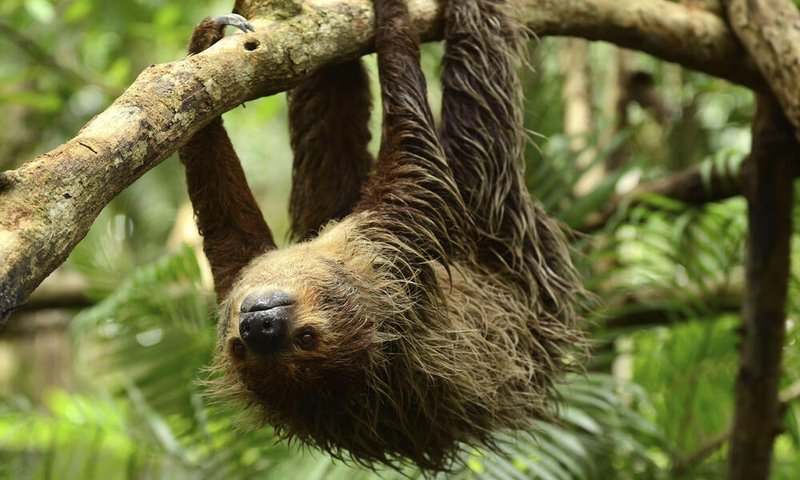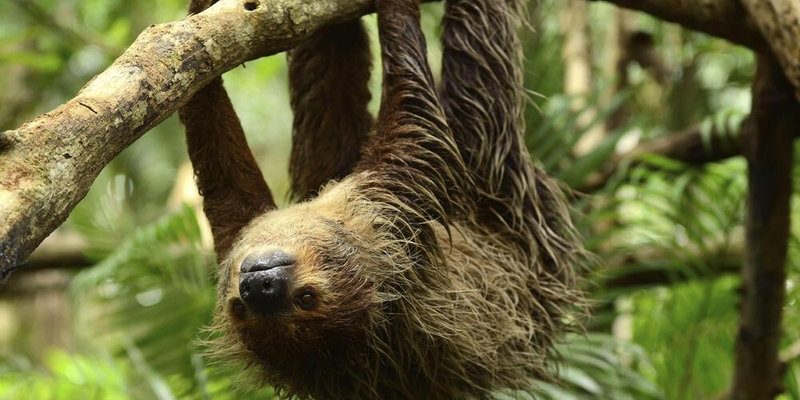
Sloths are some of the most beloved creatures in the animal kingdom. With their slow, deliberate movements and adorable faces, they capture the hearts of many. Imagine a little furry creature that takes its sweet time just hanging out in trees, munching on leaves and snoozing for most of the day. That’s a sloth for you! They’re not just slow; they’re uniquely adapted to their lush, leafy habitats.
These creatures are often associated with laziness, but there’s so much more to them than meets the eye. Sloths are fascinating in their own right, from their unusual biology and lifestyle to their role in the ecosystem. Understanding sloths gives us insight into the wonderful, intricate web of life that thrives in the tropical rainforests they call home.
Scientific Classification
Sloths belong to the animal order Pilosa, which includes two families: Bradypodidae (three-toed sloths) and Megalonychidae (two-toed sloths). They are part of the Xenarthra clade, which also includes anteaters and armadillos. Each species has its own unique traits.
The three-toed sloth is known for its slower-moving lifestyle and more easily recognizable appearance, while the two-toed sloth is a bit more agile. These animals share certain common traits, like their long limbs, curved claws, and a diet that primarily consists of leaves. Oddly enough, sloths are related to giant ground sloths that roamed the Earth thousands of years ago!
It’s also interesting to note that the first sloths appeared around 35 million years ago. Today, there are six species of sloths, each adapted to their specific environments. Like nature’s little couch potatoes, sloths have found a comfy niche in their ecosystems.
Physical Characteristics
Sloths are easily recognized by their distinct physical features. Most notably, they have long limbs and curved claws that help them hang from branches. Their fur is coarse and often hosts algae, which gives them a greenish tint—perfect for camouflage in the trees!
On average, sloths weigh between 8 to 17 pounds, depending on the species. They also tend to have a rounded face and a small nose, making them look a bit like they’re always smiling. One of the most endearing traits is their large, expressive eyes, which seem to convey a sense of calm.
Despite their slow nature, sloths are surprisingly strong. Their unique adaptations allow them to move stealthily through the canopy, helping them avoid predators. Their muscles are built for long, sustained hanging rather than quick bursts of speed. It’s a lifestyle designed for a relaxed existence!
Habitat and Range
Sloths make their homes in the tropical rainforests of Central and South America. They’re primarily arboreal animals, meaning they spend most of their time high up in the trees, where they feel safe from predators. These lush forests provide the perfect environment for sloths, offering plenty of leafy snacks and ample places to hang out.
Sloths can be found in various regions, including the Amazon Basin and parts of Central America. Within their habitat, they prefer areas with dense foliage and plenty of trees to climb. Their slow, deliberate movements make them excellent tree-dwellers, as they can easily camouflage against the green backdrop.
However, sloths are facing threats from deforestation and habitat loss. As humans cut down trees for agriculture and urbanization, the spaces where sloths thrive are shrinking. Protecting their habitat is crucial not just for sloths, but for the entire ecosystem that depends on these forests.
Diet and Feeding Habits
Sloths are primarily herbivorous, with a diet consisting mainly of leaves, fruits, and flowers. Specifically, they prefer young leaves from a variety of trees, including those from the Cecropia tree. However, their slow metabolism means they don’t need to eat as often as other animals.
One fascinating aspect of sloth nutrition is their specialized stomach, which contains bacteria that help break down the tough cellulose in their leafy meals. This process can take several days, and as a result, sloths have a very low-energy diet. They have adapted to extract as many nutrients as possible from their food.
You might wonder how sloths manage to find food in such a slow-paced manner. Well, they’ll spend several hours each day munching on leaves, and they usually return to the same trees to feed. It’s a slow, steady lifestyle that suits them just fine, allowing them to conserve energy while still getting the nutrition they need.
Behavior and Social Structure
Sloths are generally solitary creatures, often preferring to live and feed alone. They have very few natural predators due to their slow movements and camouflage, allowing them to roam their territories without too much worry. However, they do interact with other sloths during mating season or if they happen to share the same tree.
Interestingly, sloths communicate with each other using a range of vocalizations, from soft grunts to loud screams. These sounds can help them express discomfort or alert others to danger. While they might seem sleepy and slow, they are capable of expressing themselves in their own unique way.
Nocturnal by nature, sloths are most active at night when it’s cooler. During the day, they often hang upside down from branches, sleeping for up to 20 hours a day! This lifestyle might sound lazy, but it’s all part of their energy-saving strategy—sloths conserve energy by moving slowly and resting for long periods.
Life Cycle and Reproduction
Sloths typically reach sexual maturity between 2 to 5 years old, depending on the species. Mating occurs once a year, and after a gestation period of about six months, a female sloth gives birth to a single baby, known as a “slothlet.” This little one is born with its eyes open and a full coat of fur, ready to cling to its mother’s fur.
The young sloth will stay with its mother for about six months to a year. During this time, the mother will teach her baby how to navigate the trees and find food. It’s a tender bond, and the mother’s careful guidance helps the baby develop its skills for survival.
As sloths age, they can live up to 30 years in the wild, although life expectancy varies. In captivity, with proper care, they can live even longer. The life cycle of a sloth is a great reminder of how precious each stage is and how necessary it is to protect these gentle creatures in their natural habitats.
| Species | Size | Weight | Habitat | Lifespan |
| Three-toed Sloth | 24-30 inches | 8-17 pounds | Tropical Rainforests | 20-30 years |
| Two-toed Sloth | 25-28 inches | 11-18 pounds | Tropical Rainforests | 20-30 years |
Conservation Status
The conservation status of sloths varies by species, but many are considered to be vulnerable or endangered. Habitat loss due to deforestation is the primary threat they face. As rainforests are cut down for agriculture, urbanization, and logging, sloths lose their homes and food sources.
Organizations and wildlife conservation groups are working hard to protect sloths and their habitats. Efforts include reforestation projects, educational programs, and legal protections for their environments. While the situation may seem dire, every small step toward conservation can make a difference.
As individuals, we can also contribute by supporting sustainable practices and eco-friendly products. Increasing awareness about sloths and their challenges is vital. The more you know, the better chance we have to help save these incredible creatures!
Interesting Facts About Sloths
Sloths are full of quirky traits that make them fascinating. For instance, did you know that sloths only defecate about once a week? This is because their slow metabolism means they take their time digesting food. When they do go, it can be a big event, as they often climb down from their trees to find a safe spot on the ground!
Another interesting fact is that sloths are excellent swimmers! They can hold their breath for up to 40 minutes underwater and can move three times faster in water than on land. This unique skill allows them to navigate rivers and streams, which is quite impressive for such slow critters.
Sloths also have a unique symbiotic relationship with algae, which grows in their fur. While it may seem unappealing, this algae offers camouflage and provides nutrients when sloths lick their fur. Nature really has a way of making everything work out, doesn’t it?
FAQ
What do sloths eat?
Sloths primarily eat leaves, fruits, and flowers. Their diet is mostly made up of young leaves from specific trees, such as the Cecropia tree. They have a slow metabolism, so they don’t eat as frequently as other animals, but they spend several hours each day munching on their leafy meals.
How fast can sloths move?
Sloths are famously slow movers, averaging a speed of about 0.03 miles per hour. In comparison, they can swim up to three times faster than they can move on land. Their slow pace is an adaptation to their energy-saving lifestyle in the treetops.
Are sloths social animals?
Sloths are generally solitary creatures, preferring to live alone or with their young. They do communicate with each other through vocalizations, especially during mating season. While they may not be the most social animals, they interact when necessary.
How long do sloths live?
Sloths can live up to 30 years in the wild, depending on the species. In captivity, with proper care, they may even live longer. Their slow lifestyle and careful habitat choices contribute to their longevity.
What are the main threats to sloths?
The primary threats to sloths are habitat loss due to deforestation, hunting, and climate change. As rainforests are destroyed for agriculture or urban development, sloths lose their homes and food sources, putting their survival at risk.
Can sloths see well?
Sloths have relatively poor eyesight. Their vision is adapted to low light conditions, allowing them to see well in the dim light of the forest canopy. They rely more on their other senses to navigate and find food.
Are sloths really lazy?
While sloths may appear lazy due to their slow movements, their behavior is a strategic adaptation to conserve energy. Their low-energy lifestyle is essential for survival in their leafy habitats, where food is not always abundant.

